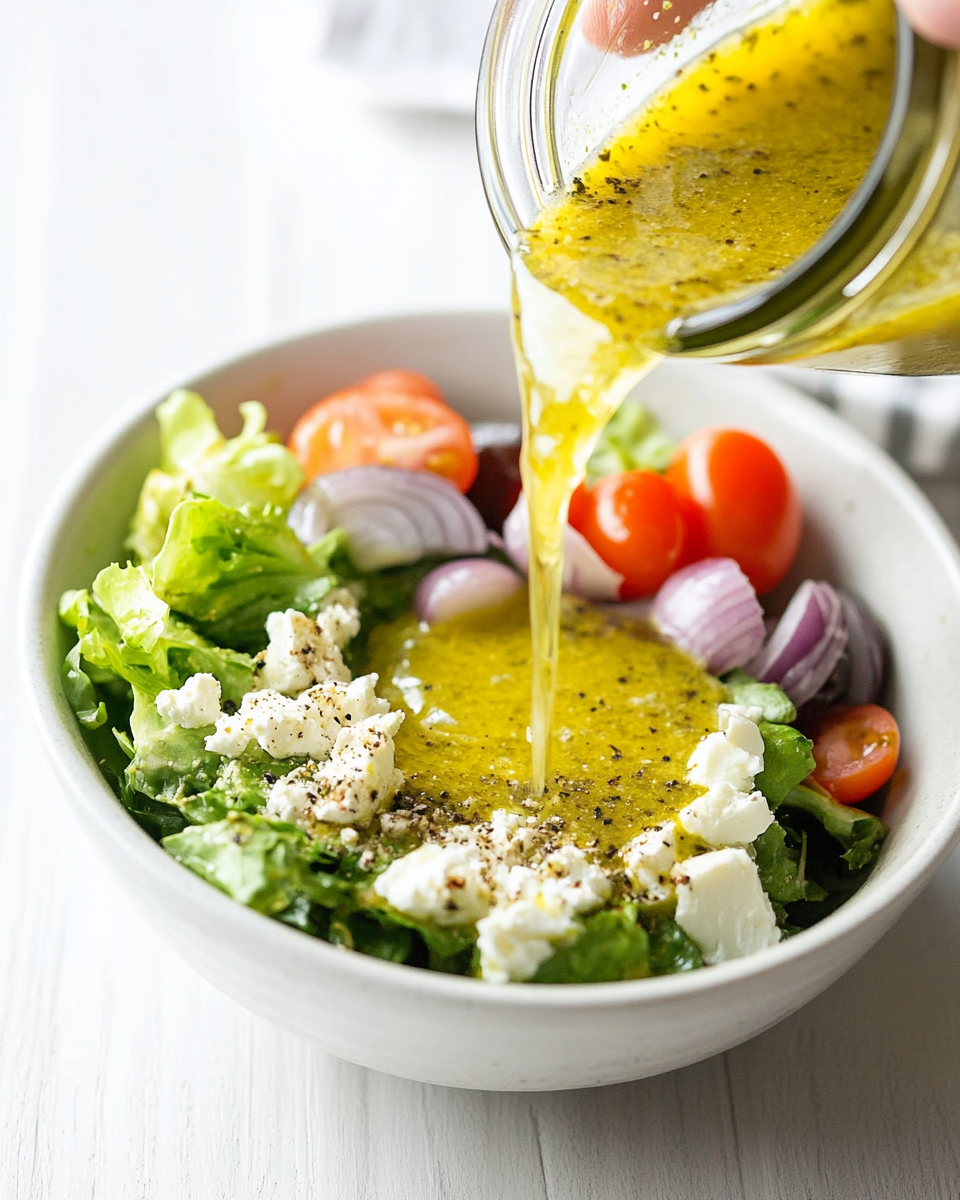When it comes to Mediterranean cuisine, a classic Greek salad dressing is an essential element that brings the dish to life. This tangy, zesty vinaigrette is not only perfect for traditional Greek salads but also doubles as a flavorful marinade for grilled meats, seafood, and roasted vegetables. Made with simple, fresh ingredients, this dressing captures the authentic flavors of Greece with every drizzle.

Why You’ll Love This Recipe
This best Greek salad dressing offers everything you want in a homemade vinaigrette. It’s:
- Ready in 5 minutes or less
- Made with wholesome pantry ingredients
- Packed with bright citrus, earthy oregano, and bold garlic
- Versatile enough to use as a salad dressing, marinade, or dip
- Naturally gluten-free and easily adaptable for dairy-free or vegan diets
Whether you are meal prepping for the week or need a quick dressing to toss with greens, this Greek vinaigrette is your answer. Its simplicity and bold flavor make it a must-have recipe in any kitchen.
Uses Beyond Salad
While this Greek salad dressing is ideal for classic Greek salads, it is equally useful for other dishes. It works beautifully as a marinade for chicken, shrimp, or vegetables. It can also be drizzled over grain bowls, pasta salads, or even used as a dipping sauce for warm pita bread. With its balance of acidity, richness, and herbaceousness, it complements everything from grilled meats to roasted vegetables.
Preparation Phase & Tools Needed
Making the best Greek salad dressing requires just a few basic tools:
- A glass jar with a tight-fitting lid
- Measuring spoons and cups
- Microplane or zester
- Garlic press (optional)
- Sharp knife and cutting board
The jar is essential for achieving a smooth emulsion. By shaking the dressing vigorously, you ensure that the olive oil, lemon juice, and vinegar combine properly without separating. This technique is not only effective but also minimizes cleanup.
Pro Preparation Tips
- Use high-quality extra-virgin olive oil for the richest flavor.
- Fresh lemon juice is preferred over bottled for optimal brightness.
- Mince the garlic finely to distribute its flavor evenly.
- Allow the dressing to sit for a few minutes after shaking to let the flavors meld.
Ingredients List
Here’s what you’ll need for this easy Greek vinaigrette:
- ¾ cup extra-virgin olive oil
- Juice and zest of 1 large lemon (about ¼ cup juice)
- ¼ cup red wine vinegar
- 1 teaspoon Dijon mustard
- 1 teaspoon dried oregano
- 1 clove garlic, minced
- ¼ cup crumbled feta (optional)
- Salt, to taste (about ½ teaspoon)
- Freshly cracked black pepper, to taste (about ¼ teaspoon)
Each ingredient plays a crucial role, from the sharpness of the vinegar to the richness of the olive oil and the earthiness of oregano.
Step-by-Step Instructions
Step 1: Combine Ingredients
In a glass jar, add the olive oil, lemon juice, lemon zest, red wine vinegar, Dijon mustard, dried oregano, and minced garlic.
Step 2: Shake to Emulsify
Seal the jar tightly and shake vigorously for 30 seconds until the dressing becomes smooth and emulsified.
Step 3: Add Optional Feta
If you’re including feta for extra flavor, crumble it into the jar and shake again to distribute evenly.
Step 4: Taste and Adjust
Open the jar, taste the dressing, and adjust the seasoning with salt and black pepper as needed.
Step 5: Serve or Store
Use immediately over your favorite salad, or store in the refrigerator for up to three weeks. If refrigerated, let the dressing come to room temperature and shake well before using.
Optional Variations
- Add a pinch of crushed red pepper for subtle heat.
- Stir in chopped fresh parsley or dill for a herbaceous twist.
- Include a teaspoon of honey to mellow the acidity if desired.
Serving Suggestions
Classic Greek Salad
The most obvious and traditional use for the best Greek salad dressing is a classic Greek salad. Toss crisp cucumbers, juicy tomatoes, red onions, Kalamata olives, and feta cheese with this dressing for a fresh, vibrant dish that captures the essence of Greek cuisine.
Grilled Chicken or Shrimp Marinade
This dressing doubles as an easy marinade for grilled proteins. Its acidity tenderizes chicken breasts, thighs, or shrimp while the oregano and garlic infuse each bite with bold Mediterranean flavor.
Roasted Vegetables
Drizzle Greek vinaigrette over warm roasted vegetables like zucchini, eggplant, and bell peppers for a simple side dish with extra depth.
Grain Bowls and Pasta Salads
For healthy grain bowls featuring quinoa, farro, or couscous, this dressing adds the perfect touch of tanginess. It also works beautifully with pasta salads featuring Mediterranean-inspired ingredients like olives, artichokes, sun-dried tomatoes, and feta.
Mediterranean Wraps and Sandwiches
Use Greek salad dressing to moisten and flavor wraps filled with grilled chicken, cucumbers, feta, and greens. It also adds a bright punch to Mediterranean-inspired sandwiches.
Pita Dipping Sauce
Pour the dressing into a small dish and serve alongside warm pita bread for dipping. The bold flavors pair perfectly with soft, chewy pita.
Tuna or Chickpea Salad Upgrade
Toss canned tuna or chickpeas with this dressing for a quick, protein-packed lunch option.
Drizzle Over Grilled Halloumi
Grilled halloumi cheese gets an instant flavor upgrade with a drizzle of this tangy dressing right before serving.
Common Mistakes to Avoid
1. Using Low-Quality Olive Oil
The richness of extra-virgin olive oil is essential for authentic flavor. Using a subpar oil results in a flat, unbalanced dressing.
2. Skipping Emulsification
If the oil and vinegar aren’t properly emulsified, your dressing will separate quickly. Always shake or whisk vigorously to combine.
3. Overpowering Garlic
One clove is plenty for most recipes. Adding too much raw garlic can overwhelm the delicate balance of flavors.
4. Over-Salting
Since feta and olives (if used in your salad) already bring saltiness, always taste before adding extra salt.
5. Neglecting the Lemon Zest
Lemon zest adds a fragrant brightness that enhances the dressing. Skipping it leaves the dressing less vibrant.
6. Forgetting to Taste and Adjust
Dressing should be balanced — tangy, savory, and aromatic. Always taste after shaking and adjust salt, pepper, or acidity as needed.
7. Adding Feta Too Early
If you’re including feta, add it after the dressing has emulsified. Otherwise, it can break apart and muddy the dressing’s texture.
8. Using Bottled Lemon Juice
Fresh lemon juice delivers brighter, fresher flavor. Bottled juice often tastes dull and overly acidic.
Side Dish Recommendations
A great dressing complements more than just salads. Here are eight Mediterranean-inspired side dishes that pair beautifully with Greek salad dressing.
1. Classic Greek Salad
A timeless combination of cucumbers, tomatoes, olives, red onion, and feta dressed with the best Greek salad dressing.
2. Greek Roasted Potatoes
Crispy potatoes tossed with olive oil, lemon juice, oregano, and garlic — perfect with a drizzle of Greek vinaigrette just before serving.
3. Orzo Salad with Vegetables
Orzo pasta tossed with cucumbers, cherry tomatoes, olives, feta, and a generous splash of dressing.
4. Grilled Zucchini and Eggplant
Grilled vegetables gain new life with a drizzle of Greek salad dressing just before serving.
5. Mediterranean Chickpea Salad
Protein-packed chickpeas paired with cucumbers, red onion, feta, and tomatoes — all tied together with tangy dressing.
6. Pita and Hummus Platter
Serve warm pita alongside hummus, olives, and a small bowl of Greek dressing for dipping.
7. Grilled Halloumi with Lemon and Oregano
A simple side of grilled halloumi gets even better with a quick drizzle of tangy dressing.
8. Lemon Garlic Shrimp Skewers
Marinate shrimp in Greek salad dressing, grill them, and serve with a fresh squeeze of lemon.
Recipe Tips for Best Greek Salad Dressing
Achieving the perfect balance in Greek salad dressing is easy when you follow a few expert tips. A dressing may seem simple, but the right techniques and ingredients make all the difference.
Use Quality Ingredients
High-quality extra-virgin olive oil is essential for the best flavor. Greek olive oil is particularly prized for its rich, peppery taste, making it the ideal base for authentic Greek vinaigrette. Always use fresh lemons instead of bottled juice for brighter acidity, and select a good red wine vinegar to provide the right tang.
Shake, Do Not Stir
Although whisking works, shaking the ingredients in a tightly sealed jar is the easiest way to fully emulsify the dressing. Shaking evenly distributes the oil and vinegar, creating a smooth texture that coats every ingredient in your salad.
Customize for Personal Taste
One advantage of homemade Greek salad dressing is the ability to adjust it to your preferences. If you like a more tangy dressing, increase the vinegar or lemon juice. For a milder version, add a touch of honey. You can also make it creamy by blending in a spoonful of Greek yogurt.
Let It Rest
For the best flavor, allow the dressing to sit for at least 5 to 10 minutes after shaking. This resting period allows the garlic, oregano, and lemon zest to infuse into the oil and vinegar.
Storage and Reheating Instructions
Proper Storage
Store Greek salad dressing in a glass jar with a tight-fitting lid. It will keep well in the refrigerator for up to three weeks. Since olive oil solidifies when chilled, expect the dressing to thicken in the fridge.
Bringing It Back to Life
When ready to use, remove the jar from the refrigerator and let it sit at room temperature for 15 to 20 minutes. If you are short on time, you can microwave the jar (without the lid) for about 5 seconds to soften the oil.
Always Shake Before Serving
Since natural separation occurs, always shake the jar vigorously before drizzling Greek vinaigrette over salads or other dishes.
Freezing
This dressing is not recommended for freezing. The emulsion will break, and the texture will become grainy. Stick to refrigerating for the best quality.
Frequently Asked Questions (FAQs)
How long does homemade Greek salad dressing last?
Properly stored in the refrigerator, Greek salad dressing stays fresh for up to 3 weeks. Always check for any off odors or cloudiness before using.
Can I make Greek dressing without garlic?
Yes, you can omit the garlic if preferred. The dressing will be slightly milder but still flavorful thanks to the lemon, vinegar, and oregano.
Is Greek salad dressing gluten-free?
Yes, this recipe is naturally gluten-free, making it suitable for gluten-sensitive diets.
Can I make it vegan?
Absolutely. Simply leave out the feta cheese for a fully vegan version.
Can I add fresh herbs?
Fresh parsley, dill, or basil add wonderful flavor to Greek salad dressing. Add them right before serving for the freshest taste.
What is the best oil to use?
Extra-virgin olive oil is ideal for both flavor and authenticity. Greek or Mediterranean olive oils provide the most traditional taste.
Why does my dressing separate?
Separation is natural for homemade vinaigrettes. A quick shake before each use recombines the ingredients.
Can I use Greek salad dressing as a marinade?
Yes, the acid and oil combination works perfectly to tenderize and flavor chicken, shrimp, or vegetables before grilling or roasting.
How do I make the dressing less tangy?
Add a small amount of honey or maple syrup to balance the acidity without compromising flavor.
Can I double the recipe?
Yes, this dressing scales up easily. Simply double all ingredients and store in a larger jar.
Conclusion
Homemade Greek salad dressing delivers bold, authentic Mediterranean flavors with just a handful of ingredients and a few minutes of your time. Its versatility makes it a staple beyond salads, adding vibrant flavor to grilled proteins, roasted vegetables, grain bowls, and even dips. Whether you are preparing a quick weekday salad or planning a full Mediterranean feast, this tangy vinaigrette brings brightness and balance to every dish it touches.
The beauty of making your own Greek salad dressing lies in its flexibility. Adjust the acidity, richness, and seasoning to match your taste preferences, ensuring that every batch is perfect for your palate. By using high-quality ingredients and following a few simple techniques, you will create a dressing far superior to anything store-bought — fresher, healthier, and bursting with Mediterranean goodness.
For even more Mediterranean recipe inspiration, check out our guides to classic Greek salad, Mediterranean grain bowls, and traditional mezze platters. Mastering this Greek salad dressing recipe opens the door to countless creative and delicious dishes.
Best Greek Salad Dressing
Ingredients
- ¾ cup extra-virgin olive oil
- Juice and zest of 1 large lemon about ¼ cup juice
- ¼ cup red wine vinegar
- 1 teaspoon Dijon mustard
- 1 teaspoon dried oregano
- 1 clove garlic minced
- ¼ cup crumbled feta optional
- Salt to taste (about ½ teaspoon)
- Freshly cracked black pepper to taste (about ¼ teaspoon)
Instructions
- In a pint jar (or any jar with a tight-fitting lid), combine the olive oil, lemon juice, lemon zest, red wine vinegar, Dijon mustard, oregano, and minced garlic.
- Cover the jar and shake well until the dressing is fully emulsified.
- If using, add the crumbled feta to the jar, then shake again to distribute evenly.
- Taste the dressing and season with salt and freshly cracked black pepper, adjusting to your preference.
- Use immediately or store in the refrigerator for up to 3 weeks.




Leave a Comment